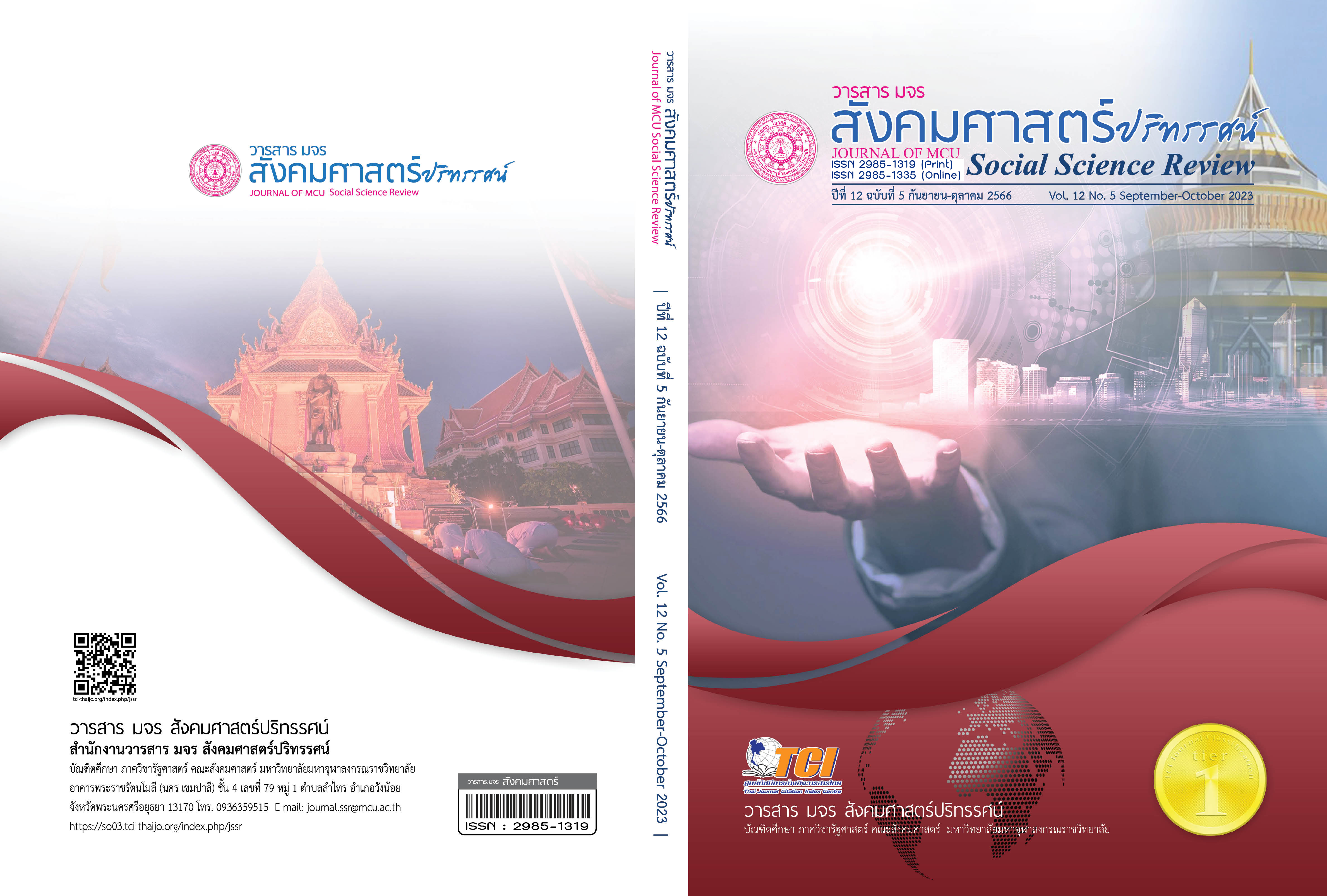การใช้สื่อสังคมออนไลน์ในการป้องกันและปราบปรามการทุจริต ของสำนักงานตำรวจแห่งชาติ
คำสำคัญ:
สื่อสังคมออนไลน์, การป้องกันและปราบปรามการทุจริต, สำนักงานตำรวจแห่งชาติบทคัดย่อ
ในสังคมยุคดิจิทัล การใช้สื่อสังคมออนไลน์ได้เข้ามามีบทบาทสำคัญในชีวิตประจำวัน ในมิติต่าง ๆ ไม่ว่าจะเป็น การติดต่อสื่อสาร การทำธุรกรรม รวมไปถึงการรับรู้ข้อมูลข่าวสารต่าง ๆ อีกทั้ง ยังสามารถทำได้ทุกที่ ทุกเวลารวมไปถึงในการพัฒนาบทบาทและการดำเนินงานของภาคประชาสังคมในการเสริมสร้างการป้องกันและปราบปรามการทุจริตของหน่วยงานต่าง ๆ ให้มีประสิทธิภาพเพิ่มมากขึ้น ดังเช่น สำนักงานตำรวจแห่งชาติ ได้เปิดโอกาสให้ประชาชนมีส่วนร่วมและบทบาทสำคัญในการชี้ให้เห็นช่องทางทุจริตในหน่วยงาน สามารถตรวจสอบการทุจริต แสวงหาข้อมูลข่าวสารการทุจริตมาเผยแพร่ให้กับคนในสังคมได้รับรู้ และยังมีส่วนช่วยในการเปลี่ยนค่านิยมที่ไม่ถูกต้องให้เป็นไปในทิศทางที่ถูกต้องได้ และการป้องกันและปราบปรามการทุจริตเชิงนโยบายของสำนักงานตำรวจแห่งชาติ ทำให้ประชาชนเครือข่ายองค์กร และหน่วยงานต่าง ๆ สามารถติดตามการทำงานของเจ้าหน้าที่ตำรวจผ่านช่องทางสื่อใหม่ เช่น ไลน์ เฟซบุ๊ก อินสตราแกรม หรือผ่านช่องทางการไลฟ์สด เพื่อชี้เบาะแส ให้ข้อมูลผู้กระทำผิดผ่านช่องทางออนไลน์ บทความนี้ ได้เสนอแนวทางการใช้สื่อสังคมออนไลน์ในการป้องกันและปราบปรามการทุจริตของสำนักงานตำรวจแห่งชาติ เป็นแนวทางการแก้ไขปัญหาของการทุจริต เปิดโอกาสให้ประชาชนมีส่วนร่วมเมื่อพบเห็นสิ่งที่ไม่ถูกต้อง ไม่ได้รับความเป็นธรรม หรือการปฏิบัติที่ไม่เหมาะสมจากเจ้าหน้าที่ตำรวจ สามารถร้องทุกข์ผ่านสำนักงานจเรตำรวจ ได้ 3 ช่องทาง ดังนี้ 1) www.jcoms.police.go.th 2) www.jaray.police.go.th 3) สแกนคิวอาร์โค้ด เพื่อร้องเรียนแจ้งเบาะแส โดยจะระบุตัวตน หรือไม่ระบุตัวตนก็ได้ทำให้เกิดความสะดวกต่อการชี้เบาะแสและช่วยสกัดกั้นการทุจริตเชิงนโยบายต่าง ๆ หรือ การทุจริตในรูปแบบอื่น ๆ เพื่อต่อต้านการทุจริตอย่างยั่งยืนต่อไป
เอกสารอ้างอิง
ฐานันท์ วรรณโกวิท. (2554). ประสบการณ์จากการฝึกอบรมเส้นทางคอร์รัปชั่น ณ มหาวิทยาลัยตูลูสกาปิโตล สาธารณรัฐฝรั่งเศส. วารสารยุติธรรมปริทัศน์, 6(6), 39-66.
นนทวัชร์ นวตระกูลพิสุทธิ์ และคณะ. (2555). การวิจัยเพื่อศึกษารูปแบบการทุจริตเชิงนโยบาย (รายงานการวิจัย). นนทบุรี: สำนักงานคณะกรรมการป้องกันและปราบปรามการทุจริตแห่งชาติ.
นภดล กรรณิการ์. (2551). เอแบคโพล : ประเมินความสุขของคำทำงาน (Happiness At Workplace). สืบค้น 5 มกราคม 2566, จาก http://www.ryt9.com
พิรงรอง รามสูต และคณะ. (2547). การกำกับดูแลเนื้อหาอินเทอร์เน็ต (รายงานการวิจัย). กรุงเทพฯ: สำนักงานกองทุนสนับสนุนการวิจัย.
พีระ จิรโสภณ. (2551). ทฤษฎีการสื่อสารมวลชน. สืบค้น 20 พฤษภาคม 2566, จาก https://www.stou.ac.th/Thai/Schools/sca/MA_TEXT/unit010.txt
ศูนย์ปฏิบัติการต่อต้านการทุจริต กระทรวงมหาดไทย. (2563). กลไกด้านการป้องกัน ปราบปรามการทุจริตและประพฤติมิชอบ และการส่งเสริมคุณธรรม จริยธรรมของกระทรวงมหาดไทย. วารสารดำรงราชานุภาพ, 20(61), 62-99.
______. (2566). แผนปฏิบัติการการป้องกันและปราบปรามการทุจริตประพฤติผิดมิชอบสำนักงานตำรวจแห่งชาติ พ.ศ. 2566. สืบค้น 20 กุมภาพันธ์ 2566, จาก http://www.huamarkpolice.au.edu/files/28-files02.pdf
สำนักงานคณะกรรมการป้องกันและปราบปรามการทุจริตแห่งชาติ. (2565). แผนปฏิบัติการด้านการต่อต้านการทุจริตและประพฤติมิชอบ ระยะที่ 1 (พ.ศ. 2563 - 2565). สืบค้น 25 กรกฎาคม 2565, จาก https://www.nacc.go.th
______. (2558). พิพิธภัณฑ์ต้านโกง. สืบค้น 25 กรกฎาคม 2565, จาก http://acm.nacc.go.th/aboutus
สำนักประชาสัมพันธ์ สำนักงานเลขาธิการวุฒิสภา. (2561). กลยุทธ์การประชาสัมพันธ์ผ่านสื่อสังคมออนไลน์ด้วยการใช้เฟซบุ๊ก (Facebook). กรุงเทพฯ: สำนักงานเลขาธิการวุฒิสภา.
สุดสงวน สุธีรสร. (2547). อาชญาวิทยา. กรุงเทพฯ: มหาวิทยาลัยธรรมศาสตร์.
สุวรรณ ไตรมาลัย. (2554). บทบาทของสื่อมวลชนต่อการป้องกันและแก้ไขการทุจริตคอร์รัปชั่น. ขอนแก่น: มหาวิทยาลัยขอนแก่น.
สุวรรณ สุวรรณเวโช และคณะ. (2561.). การปฏิรูปตำรวจ : การปรับปรุงองค์การและการบริหารจัดการ. วารสารวิจัยราชภัฏธนบุรี รับใช้สังคม สถาบันวิจัยและพัฒนา มหาวิทยาลัยราชภัฏธนบุรี, 4(1), 1-14.
เสาวนีย์ ไทยรุ่งโรจน์ และคณะ. (2553). โครงการประเมินสถานการณ์ด้านการทุจริตในประเทศไทย (รายงานผลการวิจัย). กรุงเทพฯ: มหาวิทยาลัยหอการค้า.
แสงเดือน ผ่องพุฒ. (2556). สื่อสังคมออนไลน์ : แนวทางการนำมาประยุกต์ใช้. บรรณารักษ์ปฏิบัติการ สำนักวิชาการ สำนักงานเลขาธิการวุฒิสภา, 3(20), 1-19.
อชิรวิทย์ สุพรรณเภสัช. (2540). พระบรมราโชวาทและพระบรมราโชบายในการบริหารงานตำรวจ. กรุงเทพฯ: บริษัทเพอร์เฟคท์พริ้นท์แอนด์แอ็ดเวอร์ไทซิ่ง.
Williamson, A. (2021). Social Media Guidelines for Parliaments. Retrieved March 20, 2021, from http://www.ipu.org/PDF
ดาวน์โหลด
เผยแพร่แล้ว
รูปแบบการอ้างอิง
ฉบับ
ประเภทบทความ
สัญญาอนุญาต
ลิขสิทธิ์ (c) 2023 วารสาร มจร สังคมศาสตร์ปริทรรศน์

อนุญาตภายใต้เงื่อนไข Creative Commons Attribution-NonCommercial-NoDerivatives 4.0 International License.
เพื่อให้เป็นไปตามกฎหมายลิขสิทธิ์ ผู้นิพนธ์ทุกท่านต้องลงลายมือชื่อในแบบฟอร์มใบมอบลิขสิทธิ์บทความให้แก่วารสารฯ พร้อมกับบทความต้นฉบับที่ได้แก้ไขครั้งสุดท้าย นอกจากนี้ ผู้นิพนธ์ทุกท่านต้องยืนยันว่าบทความต้นฉบับที่ส่งมาตีพิมพ์นั้น ได้ส่งมาตีพิมพ์เฉพาะในวารสาร มจร สังคมศาสตร์ปริทรรศน์ เพียงแห่งเดียวเท่านั้น หากมีการใช้ภาพหรือตารางหรือเนื้อหาอื่นๆ ของผู้นิพนธ์อื่นที่ปรากฏในสิ่งตีพิมพ์อื่นมาแล้ว ผู้นิพนธ์ต้องขออนุญาตเจ้าของลิขสิทธิ์ก่อน พร้อมทั้งแสดงหนังสือที่ได้รับการยินยอมต่อบรรณาธิการ ก่อนที่บทความจะได้รับการตีพิมพ์ หากไม่เป็นไปตามข้อกำหนดเบื้องต้น ทางวารสารจะถอดบทความของท่านออกโดยไม่มีข้อยกเว้นใดๆ ทั้งสิ้น





